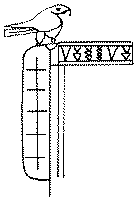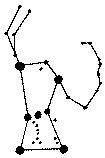Ancient Egyptians and the Constellations: Part 12
The Four Standards
The four standards to the left of the Solar Barque and decapitated bodies contain Ancient Egyptian writing, which is not entirely hieroglyphic! This means that at 4468BCE not only were Ancient Egyptian hieroglyphs in evidence, but so too was Ancient Egyptian Cuneiform writing!
Scholars would have us believe that the invention of writing is credited to the Sumerians c3500BCE. The "Kish Tablet" which is used as evidence of this shows crudely formed Ancient Egyptian hieroglyphs and Cuneiform writing!
The message on the tablet would seem to be about a man with a fish, in a boat, heading towards the three pyramids. However, assuming that the three Pyramids at Giza were not constructed at the time of the Tablet we need to search for the Sacred Meaning.

The Kish Tablet
The man with the fish is identified as Nermer: "Ner" from the fish (despite it not being a catfish) and "Mer" from the chisel down in the right hand corner of the tablet. He is wearing an Osiris Beard and is seated in the Solar Barque. As with the Solar Barque imagery on the Nermer Plate, the Kish tablet also encodes the concept of Precession. Nermer is the Lord of Precession.
To confirm his status as Nermer/Osiris/Orion the god on the Kish Tablet is identified with the three stars in the Belt of Orion and also the Osiris mummy (the "leg" with the "foot").
The name Nermer is also represented by the three cuneiform wedges … and/or Orion's Belt … and/or the Three Pyramids at Giza … and/or the Constellation of Phoenix … and/or the Osiris Mummy and the Chisel.
It is noticeable that the Chisel is not unlike the Osiris Beard. Turned upside down it is reminiscent of the White Crown, which was worn not only by Nermer on Side One of the Nermer Plate but also by the Osiris Mummy in his capacity as Lord of the Dead.
Until now the Sumerian Kish Tablet has been considered to be a form of account keeping: three of this, two of that and one of the other. In reality the Kish tablet is a legacy from the remote Ancient Egyptians concerning Precession.
The spoken language of the Ancient Egyptians was also unique. Having said that, it does share some vocabulary and semantic similarities with the Sumerians, but that is because Ancient Egyptian is the Parent Language of the Sumerians!
The information conveyed by the standards is not only about Osiris, it also re-enforces the themes of the Flood and of the Precession of the Ages of the Zodiac. The latter suggests that the remote Ancient Egyptians connected the Precession of the Ages of the Zodiac with climatic changes.

The Four Standards
North Africa was affected by the Global Warming which set in motion the end of the Ice Age. The meltdown is estimated to have begun around 16000 BCE. The Age of Libra began in 15268 BCE. This is during the Springtime of the Ages of the Zodiac: the Winter snows were melting. There was massive flooding on a global scale caused by the meltdown as well as torrential rains caused by the nature of the Water Cycle. North Africa experienced first the floods, and later the torrential rains due to the high humidity. Gradually however the Global Warming created a hot dry climate in North Africa which in turn caused the Flood waters to recede and eventually dry up. The land continued to dry out and over time the once lush vegetation became what is now known as the Sahara Desert. The River Nile became the main water supply.
The First and Second Standards
Working from right to left the First and Second Standards are of a bird sitting on what looks like a set-square, which is the Ancient Egyptian hieroglyph for "Pharaoh". The word "Pharaoh" which we use today actually comes from the Hebrew, meaning "Sun". Incredibly "Par" or "Peor" also means "Opening" and "Mountain". The words "Sun" and "Opening" and "Mountain" are immediately associated with Precession of the Equinoxes. (See Part 10)


The "set-square" is an Ancient Egyptian hieroglyph for "Pharaoh".
A "Hawk on a Standard" is an Ancient Egyptian hieroglyph for "God".
I have translated the First and Second Standards as: "(Osiris) God and Pharaoh of the Waters of Nun, God and Pharaoh of the Two Lands, God and Pharaoh of Precession.".
The Ancient Egyptian symbol for the Waters of Nun, the Flood, is on the vertical of the set-squares. They look like Nileometres or even the flood markers which we use here in Australia! The Ancient Egyptian cuneiform referring to Two Lands is on the horizontal arms. They are the two big triangles. In Ancient Egyptian Mythology, Osiris was known by the name "Lord of the Two Lands". The bird is the Hawk, Heru or Hu, representing the Sun in the Precession of the Ages of the Zodiac. In hieroglyphics the hawk on a standard represents "a god" and is interchangeable with the axe (or flag) glyph. The axe (or flag) glyph is clearly evident in these First and Second Standards.
In the context of the Precession of the Ages of the Zodiac, the Two Lands refers to the mountainous East and West Banks of the Nile. The Flood refers to the River Nile. In Ancient Egyptian Mythology Osiris was known by the title "Lord of the Land on each side of the Celestial Nile".
The Ancient Egyptian hieroglyph representing "Dawn", the rising of the Sun above the mountains or horizon, is found in the top panels, the Chiefs, of the Nermer Plate. (See Part 8)


The hieroglyph beneath the catfish and the chisel not only represents
a temple, it is also an Ancient Egyptian hieroglyph representing
Dawn, the rising of the sun above the mountains, or horizon.
In this case it represents the Dawn of the Age of Taurus.
The hieroglyphs above are profiles of the River Nile running between the two sets of mountains. The Dawn of a New Age of the Zodiac is symbolized by the Sun rising between the two sets of mountains, and above the floodwaters of the River Nile. This is the conjunction of the Sun moving through the Sacred Gateway or Portal into the next Age of the Zodiac.
The Third Standard
The Third Standard illustrates rejuvenation after the Flood: Resurrection











